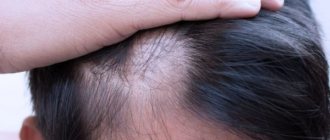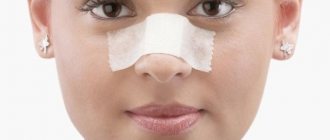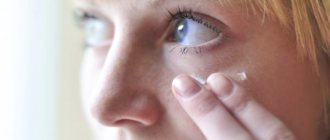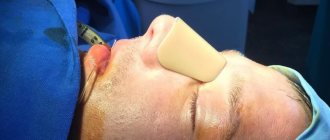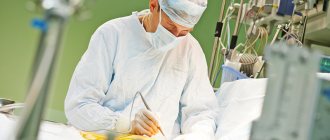One of the most common surgical operations associated with aesthetic correction of appearance is rhinoplasty. Considering that “The face is everything that is built around the nose,” deciding whether to undergo rhinoplasty is very difficult - after all, we are talking about a surgical operation, which many associate with pain and the risk of possible complications. Some ridiculous articles from the global network and common myths about rhinoplasty, which introduce additional fears and confusion into the heads of patients, contribute to the difficulty of making a decision about surgery. Let's look at some.
Myth No. 1. Rhinoplasty can be performed by any plastic surgeon.
Technically yes. Many plastic surgeons have rhinoplasty on their list of services. However, this does not mean that every surgeon can do it at the proper level. Rhinoplasty is a complex operation, both from an aesthetic and functional point of view. A good rhinosurgeon must have an excellent understanding of the internal anatomy of the nose and the functioning of the respiratory system, since nose correction changes not only aesthetic, but also functional parameters - breathing. On the other hand, no other anatomical formation affects the perception of the face as a whole as much as the nose. Therefore, a plastic surgeon involved in nose correction must have a developed aesthetic sense, which will help him achieve the best aesthetic result, taking into account the preservation or restoration of external respiratory function.
Columella - what is it?
Between the human nostrils there is a unique piece of skin called the columella. From an anatomical point of view, the nasal columella consists of the medial crura of the cartilages of the nasal wings, however, they cannot be seen. There is another name for this anatomical term: column or column of the nose.
The huge role of the columella is to perceive a person’s nose as something normal that does not interfere with existence. These qualities are inherent in a beautiful columella:
- width - no more than five to seven mm;
- in women the angle between the nose and lip is approximately one hundred degrees, in men it is ninety-five;
- there should be no sagging of the column;
- the location of the columella cannot be higher than the wings of the nose when viewed from the front.
- symmetry of the nostrils.
The success of rhinoplasty directly depends on these rules. If you do not take them into account, the image of the nose will turn out to be very incorrect, as a result of which repeated plastic surgery may be prescribed. In other cases, excellent results can be obtained with simple nose enhancement surgery.
In some cases, people may have problems with nasal columella, to solve which it is necessary to undergo rhinoplasty of the nose in Moscow. Patients of a plastic surgeon, based on what the ideal nasal columella should look like in size and shape, most often have to deal with the following problems:
- sagging of the nasal column;
- very high location of the columella;
- a very small, or vice versa large, angle between the nose and lip.
In certain cases, a person believes that his nose is large, with a curved tip, and snub. To correct the appearance, in general, there is no need for severe and traumatic operations aimed at changing the contours of the back or its tip. Changing the column of the nose will be sufficient. For this purpose, we recommend paying attention to nose rhinoplasty, the price of which will pleasantly surprise you.
Myth No. 4. Computer modeling does not allow one to accurately predict the outcome of the operation.
Computer modeling of rhinoplasty is a good tool to determine the shape of the future nose. It is important that the simulation is carried out by the surgeon himself, since at this stage the doctor outlines a plan for the future operation and clarifies which technique is best to use to achieve the desired result. Of course, the result of the operation may differ from the computer model, since nasal tissue is not an ideal plastic material such as clay or plasticine. The processes of tissue restoration and scarring are very individual and not always predictable. The patient must be aware of this. However, modern rhinoplasty cannot be imagined without computer modeling.
Rhinoplasty: pros and cons.
Good morning!
I hardly write posts, but now I really needed the advice of an experienced Internet public. Half a year has passed since my previous journalistic opus: I wrote about breaking up with a man, then we got back together, in the spring we broke up again completely and without light sadness, so somehow there was no inspiration to write. So, over the May holidays, enjoying the state of Single&Fabulous, I studied marketing, read business books, and had meetings planned (including with boyfriends). Everything was fine, and one day while doing yoga, I thought, maybe I could record a yoga lesson and post it on Youtube (I’ve had these thoughts for a long time), solely for the purpose of checking how they make money from advertising (remembering Internet money from South Park) . I'm very mercantile.
Well, I filmed it...I looked...And I understood the meaning of the term cognitive dissonance. I always considered myself a beauty, I heard this from people, and I objectively assessed my appearance, and understood that it had a twist (the main highlight is my nose, yes, yes, we will talk about it), that I am a non-standard beauty, I am more Gisele or Kate than Heidi. And then I watched the video and realized that I was not Giselle after all... You can imagine how hard it was for me to accept the harsh reality.
And I thought, why not become more beautiful? and you can't fix your nose...
My nose is large, quite large, on Gossip in the comments they usually call them “that’s a snob.” The greatest resemblance to the profile of Lady Diana (in general, my type), it seems to me that I will have even more. But since adolescence I have not had complexes, other harmonious features and figure perfectly compensate for such a deficiency, I have not suffered from the lack of attention from men, and even now I consider myself very good (especially in combination with Scorpio magnetism).
But unconsciously, I still worry a lot about my appearance. For a photo, I choose the winning frame, and I know how to create a slim nose using filters. And as they say, your true face is what you see when the front camera accidentally turns on. It happens that you shy away. Well, our people are “kind”, one of my former colleagues (not a fashion model at all) asked to my face a couple of years ago: “Why don’t you do your nose?” Then, of course, she apologized, but the aftertaste remained. In general, we can continue endlessly. Bottom line: I signed up for plastic surgery, it is scheduled for the fall, next week I will have modeling, and due to the paperwork and money aspects, there will be no way back without material losses. I won’t mention the doctor’s name or the name of the clinic; the money issue is of course palpable, but that’s not the main thing; I trust the specialist as much as I trust myself.
There is fear, and very big, doubts too. This morning I woke up with the thought: do I really need it? After all, I don’t work on television, appearance is not my calling card. And in general, beauty is fleeting, and I have always believed that it is from within that what attracts people and circumstances comes. So it might be better to stop focusing on the external and work on your essence.
And therefore I would like to know the opinion of those gossips who had rhinoplasty done (or from the experience of friends). And please answer a few of my questions.
1) Have you become happier? Have you gained confidence in yourself? Has your life changed?
2) Was everything done correctly the first time or did you have to do it again?
3) Is it very painful? On a scale from 1 to 10. It somehow affected my health in the future. After surgery, I don’t want to feel an ache in my nose every time the weather changes.
4) Have you settled on rhinoplasty (or continued “improving”)? Have you worked with a psychologist before or since?
I understand that there are specialized sites, but I would not like to read stories about how long it takes for the cast to be removed and the swelling to subside, and “oh, I’m so happy, so happy” a week after the operation. Is it worth it in the long run?
And if there were unsuccessful cases, I would also like to read about them. Perhaps someone regretted their decision, and I also wonder why?
And so that the post carries an informative load, I will add before and after photos of celebrities.
This is what I don't want:
Always looking at Ivanka Trump, I think her nose is disproportionately small for her face. I thought it was mine, then I came across these photos, damn, why so tiny?
That's how I like it.
Thanks to everyone who subscribes.
And finally, photos of women who kept everything as is and are quite happy.
Wishing you self-confidence, love and happiness!
So are you for or against rhinoplasty?
Myth No. 6. “Everyone will immediately understand that I had surgery”
What's wrong with that? You are working on yourself, and, in my opinion, you are worthy of respect. If before the operation the nose had pronounced defects - a large hump, an axial curvature, a significant length, then those around you can notice such changes immediately. If the operation performs only the correction of small defects, for example, changing the tip of the nose or minimal correction of the entire nose, then for most the fact of the operation will go unnoticed. Only we ourselves know our face well, so plastic surgery is done, first of all, for ourselves, and not for everyone else.
Myth No. 7. Rhinoplasty is painful
A fairly common myth is that rhinoplasty is a painful operation. If we compare this operation, for example, with breast augmentation or abdominoplasty, we can say that it is painless. Moreover, with the availability of modern methods of anesthesia, this issue can be considered irrelevant. The operation is performed in a state of medicated sleep, and the patient does not feel anything. In the postoperative period, patients are more concerned about tampons in the nasal cavity, which are removed the next day after surgery, and swelling around the eyes, which disappear within 2 weeks. Rhinoplasty is not painful at all.
Despite significant advances in the field of facial plastic surgery, some complications after the rhinoplasty procedure still exist. Risks of rhinoplasty can be temporary or permanent, and include nosebleeds, infections, bone deformities, nasal septum injuries, and noticeable scarring.
Rhinoplasty is a minimally invasive procedure performed to change the shape and size of the nose. For every person, the appearance of the nose is a hereditary trait. Rhinoplasty, also known as nose surgery, is a type of facial plastic surgery. In very rare cases, this cosmetic treatment is combined with reconstructive surgery to solve problems related to the nose. Before engaging in this procedure, you should take into account the possible risks and complications of rhinoplasty and make the right decision.
Understanding Rhinoplasty
The rhinoplasty procedure is performed under general anesthesia and on an outpatient basis. This usually lasts for 2 hours, but the operation time may be extended for additional corrections. Reshaping the nose requires changing the cartilage to achieve the desired appearance. And depending on the actual approach, it can be reduced or increased. If the procedure is performed for cosmetic purposes, the patient will be discharged on the same day.
What are the risks of rhinoplasty?
Each candidate should consult with an experienced surgeon about the procedure for nasal surgery, associated risk factors and outcomes. The surgeon will explain what complications may arise and what the nose will look like after the operation. Compare the pros and cons and make a firm decision on whether to undergo facial plastic surgery. Who should not have rhinoplasty? Children and teenagers under 16 years of age should not participate in this operation unless it is an emergency.
Like other surgical procedures, the risks of rhinoplasty that last for a short period of time are quite obvious. For example, unusual reactions to anesthesia. This negatively affects the ability to think logically and body coordination. Therefore, the candidate is expected to refrain from driving for 2 days after surgery. Other temporary side effects are pain, swelling, redness, bruising, and numbness in the operated area. Other risks of rhinoplasty are discussed below.
- Nosebleeds are a common risk associated with changes in the shape of the nose. It may appear soon after surgery or within 7-10 days after the procedure. Therefore, repeated episodes of nosebleeds during the recovery period should not be taken seriously. The surgeon will monitor the condition to avoid any serious complication.
- Because rhinoplasty involves excision of skin and changes to cartilage, infection . For such cases, a full course of antibiotics is required in the postoperative period.
- Slight bone deformation is a common complaint among patients who have had their nose shaped. The bottom line is that not all people who have had a nose job are satisfied with the results. In other cases, a bone deformity can cause difficulty breathing through the nose and nasal congestion.
- In about 10 percent of surgery patients, the shape of the nose changes and requires revision rhinoplasty . This refers to a minor surgical procedure that aims to adjust the nasal cartilage to correct the deformity. Therefore, subsequent adjustments as directed by the surgeon are very important for all patients.
- Scarring is another complication of the shape of the nose. Although the scars disappear completely in most cases, for some people they may remain permanently. Once the scars have healed, the shape of the nose may change and, if necessary, additional surgery is performed to change the appearance of the nose.
- Regardless of whether it is a closed or open type of surgery, it can damage the nasal septum (the partition that separates the nostrils). For severe injuries, the surgeon may consider performing minor surgery to restore normal nasal function.
This was a brief explanation of rhinoplasty and its risks and complications. In conclusion, I would like to say that this operation is a relatively safe procedure for healthy adults. Possible complications are mainly individual and vary from one patient to another. In order to achieve satisfactory results and minimize risk factors, choose only high-quality rhinoplasty services in Samara and trust nose surgery only to professional plastic surgeons who have extensive experience in this field.
Myth No. 8. Rhinoplasty is done only by those who are concerned about their appearance
There is an opinion that rhinoplasty is only an aesthetic operation that changes the shape of the nose, but it is unacceptable to make a beautiful nose proportional to the face that “will not breathe.” In my practice, I often combine two operations in one - rhinoplasty and septoplasty (plasty of the nasal septum).
A well-performed rhinoplasty helps improve self-esteem and emotional well-being, which significantly improves the patient’s quality of life. However, you cannot count on the fact that rhinoplasty will allow you to return or acquire a husband or wife, although the chances in such matters often increase 
These are the most common myths about rhinoplasty, but there are others. Do not increase the number of myths by trying to obtain information from unreliable sources; ask questions directly during a consultation with a professional plastic surgeon.
Clear knowledge and a positive attitude are the best way to a new appearance.
Special risks and complications
Functional disorders
Some nasal deformities cause breathing problems. In these cases, rhinoplasty is used to improve nasal function. On the other hand, rhinoplasty can reduce the cross-sectional area of the nasal airways. As a result, 10% of patients after primary rhinoplasty complain of residual or new breathing problems.
In 70% of patients undergoing secondary rhinoplasty, respiratory problems are the main complaint, primarily due to residual deviations of the nasal septum.
Problems with the nasal valves that regulate air flow are very often caused by separation of the upper lateral cartilages from the nasal septum. A deep osteotomy can narrow the airway at the pyriform aperture (the front bony opening of the nasal cavity). In most cases, however, rhinoplasty does not impair respiratory function.
The patient's complaints of nasal congestion may be caused by loss of sensitivity of the mucous membrane. The sensation of warm and cold air during breathing is important to assess nasal function. Loss of sensation caused by surgical scars can cause the nasal airways to feel blocked.
Transplantation and implants
The main risks of placing implants and grafts in the nose are infection, extrusion (displacement in the soft tissues of the nose), distortion (curvature) and resorption (death of cartilage cells). Overall, these complications occur in less than 1% of cases. Silicone, Proplast, Gore-Tex, and the patient's autogenous cartilage are used as implants. With adequate techniques, the risks are minimal even in long-term follow-up.
The main risks of autologous grafts are distortion and resorption, while alloplasts can cause infection and extrusion. Resorption occurs as a result of the death of the main cells of cartilage - chondrocytes, which support the structure. Silicone implants can have a complication rate of 5 to 20%. Fewer adverse effects were noted with other materials, such as Gore-Tex.
Complications of the skin and soft tissues
Acute complications of the skin and soft tissues include:
- edema,
- hematomas,
- local skin infections,
- necrosis,
- cysts arising from displaced mucosal cells,
- subcutaneous granulomas.
Swelling and hematomas in the periorbital area as a consequence of rhinoplasty are normal and cannot be called a significant complication. Subcutaneous mucous cysts are observed relatively often. They are caused by dislocation of the mucous membrane into the subcutaneous layers, for example, during osteotomy. Removal requires an external skin incision. In some cases, an endoscopic approach is possible.
Numbness as a consequence of rhinoplasty is quite common in some areas. Very often the tip of the nose and the lower part of the nasal septum (nerve Nasalis externus) are affected by numbness. This nerve exits the nasal cavity between the nasal bones and the upper lateral cartilages. Sensitivity is usually restored within 12 months.
Infections, systemic and rare complications
Despite the fact that rhinoplasty is a “non-sterile operation”, infections are observed in less than 1% of all procedures. Infections are rare but sometimes life-threatening (toxic shock syndrome). The risk of infection, however, may increase when rhinoplasty is performed in combination with sinus surgery due to purulent sinusitis. Bacteria (Streptococcus) can invade the osteotomy area and cause serious consequences. Therefore, combining rhinoplasty and sinus surgery is not recommended.
Osteotomy may cause injury to the orbital region. Orbital complications after rhinoplasty can be traumatic or infectious. Swelling can impair tear drainage. Streptococci can cause necrotizing infections of the periorbital or orbital areas. Blindness after rhinoplasty can be caused by occlusion of the central retinal artery. In addition, embolization is possible as a result of intranasal administration of local anesthetics.
Vascular and endocrine complications can be life-threatening and are not as rare as expected. There are reports of encephalitis, brain damage, aneurysm, and cardiac arrest after rhinoplasty.




